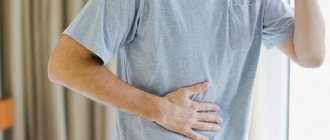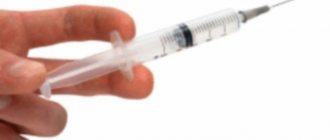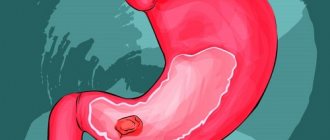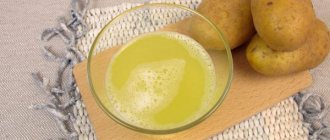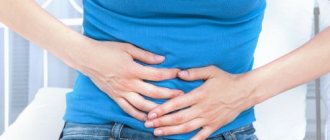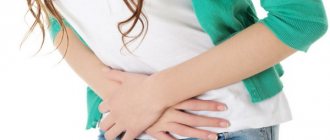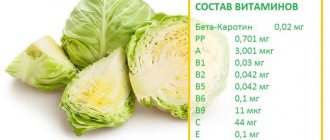The appearance of an ulcer
In most cases, an ulcer appears as a result of trauma to the stomach or its damage under the influence of various factors. The disease is chronic and can occur with exacerbations, which are characterized by pronounced pain symptoms. After proper treatment, the wound begins to gradually close, which leads to the elimination of pain and other symptoms. Among the main causes of the disease are the influence of factors such as excessive consumption of alcohol and tobacco, disruptions in diet, gastritis and exposure to stress. Heredity also plays a major role in the formation of ulcers. The pain that occurs with a stomach ulcer increases within 30-60 minutes, after which it begins to subside. Also, pain occurs 1.5-2 hours after eating. Hunger pain and stomach pain at night may also occur.
Appetite
Changes in appetite are mostly associated with pain. In patients with ulcers in the stomach, appetite is reduced or completely absent, since they experience pain after eating. Some patients are even afraid to eat because of this. With a duodenal ulcer, on the contrary, the appetite is increased, since the feeling of hunger causes painful attacks in them, and eating can relieve pain.
Digestive dysfunction due to stomach and duodenal ulcers is also manifested by constipation and bloating.
Pain relief
Partial neutralization of pain may occur after drinking a glass of warm milk. Antacids (for example, Almagel or Maalox) can quickly relieve pain.
When treating an ulcer, the goal is to reduce the amount of hydrochloric acid in the gastric juice, which will have a positive effect on the condition and help reduce the intensity of the syndrome. Among the drugs that can also relieve pain are inhibitors (Pantoprazole, Omeprazole), H2 blockers (Ranitidine). Also, if discomfort occurs, you should take medications that will protect the gastric mucosa (for example, De-nol or Venter).
To avoid another episode of pain, you should follow the diet created by your doctor. Meals should be taken in small portions 5-6 times a day. When an ulcer worsens, it is prohibited to consume alcohol, black bread, fatty foods, pickles, various broths, smoked foods, strong tea, canned food and soda. These products irritate the gastric mucosa, which can lead to pain.
To relieve symptoms of abdominal pain, you should not take medications such as Aspirin, Ibuprofen, Diclofenac, etc. Medicines can cause serious inflammation in the stomach, thereby not only weakening, but also increasing pain. Paracetamol can have a neutral effect on the nature of pain, which should be taken if necessary to treat other diseases. You should also consult a doctor for advice on treatment of the ulcer and the possibility of alleviating other symptoms of the disease.
According to medical observations, 1/10 adults suffer from stomach ulcers. The disease ranks second in frequency after coronary heart disease. Men under fifty years of age are most often affected.
Pain due to a stomach ulcer is considered an important diagnostic sign. However, statistics warn that from 25 to 28% of cases are atypical. In this case, the pain is completely absent or resembles other diseases. Pathology is detected by chance.
If the course is favorable, then after exacerbations (3–8 weeks) a long-term remission occurs, up to several years. During this period, patients must follow nutritional recommendations and regularly take courses of preventive treatment. If things go wrong, severe complications are expected with rupture of the stomach wall (perforation) and the development of peritonitis, perforation into neighboring organs, and cancerous degeneration.
What to do if your stomach hurts: first aid at home
Stomach pain is a fairly common complaint among patients. Such discomfort contributes to a significant decrease in the quality of life, especially if the pain syndrome begins to bother you more and more often. What to do if your stomach hurts and there is an intestinal disorder?
Any pain requires finding out the cause of its origin, especially in the stomach area, as it can be a symptom of a serious gastrointestinal disease. Therefore, self-medication in this case is impossible. Careful diagnosis and comprehensive treatment are necessary to prevent the occurrence of stomach pain.
Types and nature of stomach pain
Depending on the course of the pathological process, the pain in nature for each disease will be specific, such as:
- mild and aching pain provoked by eating during chronic gastritis or malignant formation;
- pain in the form of cramps is more typical for functional stomach disorders;
- acute burning pain in the stomach is a sign of a burn to the organ mucosa due to chemical poisoning;
- aching pain in the stomach during a peptic ulcer, sharply intensifying to the feeling of a “dagger strike”, is characteristic of perforation of the ulcer.
Possible causes of stomach pain
The appearance of aching pain in the stomach can have origins both related to the pathology of the organ itself and to other organs of the abdominal cavity. The most common causes of pain in the stomach are:
- gastritis is an inflammatory process in the gastric mucosa, which causes the most frequent occurrence of pain;
- ulcer of the stomach and duodenum;
- benign tumors ( polyps ) cause pain, but in rare cases;
- malignant volumetric process - as it develops, it begins to manifest itself as aching pain in the stomach associated with eating;
- acute food poisoning , accompanied by pain, caused by spasm of the smooth muscles of the stomach;
- burn of the gastric mucosa , causing pain due to chemical aggressive agents entering the stomach;
In addition to pathology from the stomach, aching pain can be caused by a pathological process in other organs of the abdominal cavity. These may be the following diseases:
- diaphragmatic hernia - periodic migration of organs from the abdominal cavity into the chest through a pathological diaphragmatic opening;
- pancreatitis is an inflammatory process in the pancreas, anatomically adjacent to the posterior wall of the stomach;
- esophagitis - inflammation of the mucous membrane of the lower esophagus entering the stomach;
- functional stomach disorders, causing pain due to a malfunction of the nervous system;
- various pathological processes of the liver;
- diseases of the large intestine, in particular colitis, which gives intense pain in the upper abdomen, which subsides after 2-3 days, but remains and is permanent.
Painful sensations in the stomach can have other causes. As a rule, a pathological process in the digestive system, accompanied by pain, is most often a serious disease. But what to do if you have stomach pain and how to get rid of it?
What examination needs to be done
Any pain localized in the stomach area requires mandatory examination, which consists of the following measures:
- collecting an anamnesis of the disease - when the pain appeared, what nature it is, how often and for how long it bothers you, whether it is associated with food intake or appears on an empty stomach, where it is most often localized;
- objective data - include examination of the oral cavity, whether there is plaque on the tongue and, if so, what color. The abdomen must be palpated to determine the presence or absence of pain, and in which area. Whether there is an enlargement of the abdominal organs or not, that is, the symptoms of the disease are revealed;
- laboratory testing - blood and urine for general analysis, feces for occult blood, gastric juice analysis, biochemical blood test, if indicated, blood for tumor markers;
- instrumental examination - ultrasound of the abdominal cavity, MRI, gastrofibroscopy.
As a rule, such an examination allows you to find out the cause of stomach pain and prescribe quality treatment. In some cases, during differential diagnosis, material is taken for a biopsy from the problem area of the organ and its subsequent histological examination.
First aid for stomach pain
Providing first aid for stomach pain is important for many patients. Pain can occur even in people who do not have digestive problems.
This may be simple overeating, drinking alcohol or fatty foods in large quantities, an allergic reaction of the body to certain foods, physical fatigue or a stressful state. Minor periodic pain in the stomach can occur in women during pregnancy, when the growing uterus begins to put pressure on neighboring organs.
As a rule, such stomach pains are temporary and do not appear again when the cause is eliminated. What to do if you have a stomach ache? In this case, it is necessary to assist the patient by performing the following measures:
- put the patient in bed and unfasten the clothes that are compressing the abdominal area;
- to relieve spasms of the smooth muscles of the stomach, the use of non-carbonated mineral water or no-shpa tablets is recommended;;
- Drinking warm mint tea has a good effect in relieving pain.
If stomach pain appears due to a stressful situation, the use of mild sedatives, such as valerian, motherwort, has a beneficial effect on the stomach and relieves pain.
Treatment with medications
Painful sensations in the stomach appear and depend on a number of reasons that cause this unpleasant state of the body. Drug treatment is aimed at eliminating inflammation in the mucous membrane of the organ and relieving pain in the stomach:
- for gastritis and stomach ulcers, accompanied by belching, heartburn, nausea, the use of drugs that reduce the production of hydrochloric acid and relieve irritation of the organ mucosa is indicated - Gastal , Almagel , De-Nol , Gastrofarm ;
- for pain caused by errors in eating against the background of gastritis with low acidity, accompanied by heaviness in the stomach - Festal , Mezim Forte , Enzistal , Pancreatin ;
- for painful sensations in the organ caused by poisoning and accompanied by intoxication of the body with fever and vomiting - Polysorb , Enterosgel , Smecta ;
- for inflammatory and infectious processes caused by microbial or viral infection - broad-spectrum antibiotics;
- pain in the stomach during chemotherapy, accompanied by diarrhea, flatulence as a result of the toxic effect of this treatment method - No-shpa , Almagel , Imodium , Espumisan .
It is possible to treat stomach pain with medications only on the recommendation of a doctor after determining the cause of the pain syndrome.
What to do for pain at home
If your stomach hurts, what can you do at home and how to relieve the pain? In this case, the use of folk remedies in the form of various decoctions or infusions gives a positive result in relieving pain. The most popular and most effective are the following recipes:
- drinking freshly squeezed cabbage juice (200 ml) with a tablespoon of honey;
- drinking freshly squeezed potato juice (200 ml) with a tablespoon of honey;
- drinking warm olive or sea buckthorn oil, 15 g 4 times a day;
- infusion of flax seeds;
- infusion of calamus root;
- infusion of chamomile, mint, calendula in equal proportions.
The preparation of infusions is carried out in the proportion of 1 tablespoon of medicinal raw materials per glass of boiling water, followed by infusion for an hour and consumption of 100 ml three times a day. The use of traditional medicine is also possible on the recommendation of a specialist.
What are the causes of stomach pain and how to solve the problem can be found in this video.
When an emergency visit to a doctor is required
Sometimes, acute pain in the stomach requires emergency medical care, since the developing pathological condition can pose a threat to the patient's life. Acute conditions that require immediate consultation with a specialist include:
- perforation of a stomach ulcer - a characteristic feature is the appearance of acute pain, forcing the patient to take a certain position in order to reduce its intensity. The pain syndrome is accompanied by weakness, increased cold sweating, a drop in blood pressure and a rapid pulse;
- poisoning by chemicals entering the stomach from the outside;
- blunt abdominal trauma accompanied by acute pain.
Only timely identification of the causes of stomach pain and prevention of its development will help the patient maintain his quality of life at a high level.
Source: https://GastrituNet.online/bolezni-zheludka/syndromy/boli/chto-delat-esli-bolit-zheludok.html
What criteria characterize ulcer pain?
Pain syndrome is considered the most typical manifestation of gastric and duodenal ulcers. The symptom is caused by direct erosion not only of the inner mucosa, as with inflammation of the stomach, but also of the submucosal, muscular layer, where there are quite a lot of pain receptors.
Gastritis is considered a precursor to ulcers. Ignoring timely treatment worsens the condition of the organ and digestion as a whole. In order to fully characterize which pain is most typical with a stomach ulcer, you should dwell in more detail on the description of the symptom.
Localization
75% of patients have abdominal pain in the epigastric zone and upper part. Depending on the specific location of the ulcer in the stomach, the area of maximum pain varies:
- if the lesion concerns the cardiac and subcardial region - under the xiphoid process of the sternum;
- in the body area - the left side of the epigastrium;
- in the pylorus and duodenum - on the right in the epigastrium.
Intensity
In half of the cases, patients consider the pain tolerable, in 1/3 of the cases it is severe. More pronounced at a young age and with complications. They are relieved by taking alkaline mineral water, drugs that suppress the secretion of gastric juice (Omez, Famotidine), antacids (Gastal, Almagel).
What are they connected with?
There is a clear connection - with food intake, with the time of year (exacerbations in spring and autumn). Depending on the food, it is customary to divide pain:
- Early - they begin half an hour to an hour after eating, increase gradually, last up to two hours, decrease, then disappear when the food bolus passes into the intestine. More typical for localization of the lesion in the body of the stomach. If the ulcerative process affects the cardiac, subcardial and fundic sections, it appears immediately after swallowing food.
- The late ones bother patients one and a half to two hours after eating, unlike the “early” ones, they intensify as the contents pass into the duodenum. Typical for ulcers located in the pyloric region and in the duodenal bulb.
- At night or “hungry” - they occur two to four hours after dinner and are relieved by eating. Typical for localization in the duodenum, pyloric section of the stomach.
How to treat stomach ulcers - effective medications, diet and treatment with folk remedies
› Ulcer › Treatment ›
Among diseases of the digestive system, gastric ulcer occupies a leading position. The causative agent is Helicobacter pylori, a pathogenic microorganism that penetrates the submucosal layer.
Treatment is a set of measures, including medications for stomach ulcers, maintaining a certain diet, and using traditional medicine recipes.
The main objective of the therapeutic course is to destroy Helicobacter, reduce acidity, eliminate heartburn and other unpleasant manifestations of the disease.
Drug therapy
It is quite difficult to cope with stomach ulcers without the help of medications. Treatment based only on dietary adjustments and the use of traditional medicine recipes can last for months. Drug treatment for stomach ulcers can achieve results within a few days. Based on the direction of impact, they are divided into several groups.
Treatment of peptic ulcers is carried out using a combination of different types of drugs. Before treating an ulcer, a thorough diagnosis is carried out.
Antibiotics
The purpose of antimicrobial drugs is to prevent the development of bacteria that cause the disease or completely destroy them. Antibiotics are included in the therapeutic and prophylactic course. The following drugs belong to this group:
- Clarithromycin is the main antibiotic for the treatment of gastric ulcers and is a macrolide. It has a high resistance to the action of hydrochloric acid, is easily absorbed, quickly spreads through the tissues, and the half-life is quite long.
- Tetracycline. Causes the death of pathogenic bacteria by disrupting protein synthesis. The antibiotic is effective against many pathogenic microorganisms, including Helicobacter pylori.
- Amoxicillin is a semisynthetic drug from the penicillin group. It is resistant to the action of gastric juice and is absorbed by 93%. It stays in the body much longer than other drugs, which makes it possible to take Amoxicillin no more than twice a day.
- Metronidazole is a drug belonging to the group of vital drugs. It is a synthetic analogue of the natural antibiotic Azomycin. Has a destructive effect on the DNA of pathogenic microorganisms.
The list of drugs in this group is quite large. It is impossible to say which medicines are the best. Their effectiveness depends on various parameters. When using many of them, side effects often occur, so constant monitoring of the patient by the attending physician is required.
Drug treatment necessarily includes a course of antibiotics. A positive result makes it possible to create a large number of combinations of different regimens and select an individual therapeutic course.
Antacids
They are used to provide an antimicrobial effect, to protect the mucous membranes and remove toxins. Helps reduce the activity of enzymes that aggravate the course of the disease. Antacids do not treat stomach ulcers, they only help alleviate the patient's condition by eliminating unpleasant symptoms. Available both in tablets and in the form of injection solutions. The treatment regimen includes:
- Almagel is an effective remedy, popular due to its analgesic and enveloping effects. By actively absorbing toxins and preventing the absorption of phosphates, the drug performs a protective function in relation to the gastric mucosa.
- Gastal. It has a combined composition, including magnesium carbonate and aluminum hydroxide. With its help, gastric secretion is neutralized, and within 2 hours after taking Gastal, a normal pH level is maintained in the stomach. Perfectly eliminates pain and heartburn.
- Maalox is another drug that neutralizes hydrochloric acid and prevents its further secretion.
- Sodium bicarbonate. Many people know how to treat heartburn - ordinary baking soda helps in such cases. It is also used for ulcers, gastritis, and against acidosis resulting from intoxication.
- Phosphalugel. The drug is based on aluminum phosphate. Phosphalugel is able to reduce the activity of pepsin, an enzyme that breaks down proteins.
With prolonged use of high doses of drugs containing aluminum, complications such as encephalopathy and osteopathy are possible.
Antispasmodics
It is very difficult to manage without painkillers for ulcers. They alleviate the patient's condition by providing an analgesic effect during the treatment process. The use of a complex of several drugs is effective. The group of antispasmodics includes:
- Dibazol. Normalizes blood pressure, eliminates not only muscle pain, but also headaches. The disadvantage is that the effect does not last long, so it is often necessary to use more modern drugs to treat peptic ulcers.
- Galidor. The main component is bencyclar, which has the ability to block sympathetic nerve ganglia. Halidor eliminates muscle spasms, acting as an effective pain reliever.
- No-Shpa is one of the most popular antispasmodics. Has a pronounced and long-lasting effect. By hindering the penetration of calcium into smooth muscles, it perfectly relieves pain from gastric ulcers. No-spa is prescribed in cases where there are contraindications to taking anticholinergic drugs, which are more effective as painkillers, however, they are not suitable for everyone.
- Papaverine is an antispasmodic that acts less pronouncedly and for a short time. Its effect is not enough to protect against severe pain that occurs with a stomach ulcer.
Despite the fact that most antispasmodics are available without a prescription, they should be used only as prescribed by a gastroenterologist.
Histamine receptor blockers
The main task of drugs for the treatment of stomach ulcers included in this group is to turn off receptors in the parietal cells of the glands in order to reduce the secretion of gastric juice, resulting in reduced inflammation. Blockers include:
- Ranitidine. By reducing the activity of pepsin, the process of protein breakdown slows down. The drug is able to protect the gastric mucosa from the negative effects of hydrochloric acid for 24 hours.
- Roxatidine. Blocks histamine H2 receptors. Normalizes the acid-base balance, is instantly absorbed, providing a therapeutic effect one hour after administration. The effect of use can last up to 24 hours.
- Nizatidine. Refers to III-receptor blockers. Firmly maintains normal pH levels for 12 hours.
- Cimetidine. A topical drug that blocks III receptors. Showing good results in regulating acidity levels and suppressing the synthesis of hydrochloric acid, Cimetidine has a much lower cost compared to other medications in this group. The disadvantage is the short validity period, which does not exceed 8 hours.
- Famotidine. It is an effective drug for stomach ulcers, protecting the mucous membrane from the harmful effects of histamine, pepsin, acetylcholine and gastrin.
- Kvamtel. The active ingredient is famotidine. Treatment of ulcers of the esophagus and stomach is due to its ability to block the secretion of hydrochloric acid.
According to experts, histamine receptor blockers enhance the effect of antibiotics.
Anticholinergics
When treating stomach ulcers with medications, a large role is given to drugs in this group. They not only reduce the secretion of gastric acid, but also relax the smooth muscles of the gastric walls, allowing for prolongation of the action of antacids. The group of anticholinergic drugs includes:
- Gastrocepin is an M-cholinergic receptor blocker. It is distinguished by its ability to act only on the gastric mucosa, without inhibiting the activity of the salivary glands, eyes, and heart muscle.
- Platiphylline is a drug that blocks M-cholinergic receptors and, to some extent, N-cholinergic receptors. In addition, it has a relaxing effect on the walls of the stomach, dilates blood vessels, which leads to a decrease in pressure.
- Buskopan. By blocking M-cholinergic receptors, it simultaneously reduces the production of gastric juice, alleviating the patient’s condition.
- Etpenal . Capable of blocking both types of cholinergic receptors. Has a positive effect on the nervous system.
- Metacin is a drug that, in addition to blocking M-cholinergic receptors, inhibits the production of gastric juice and saliva, and regulates blood pressure. Side effects are rare.
Anticholinergic drugs are prescribed for stomach and duodenal ulcers. Having a suppressive effect on the secretion of gastric juice, most of them have virtually no effect on the intestinal phase.
Reparants
This group includes medications that increase the regenerative functions of the gastric mucosa, improve blood microcirculation in the affected areas and restore trophism. Relatives include:
- Solcoseryl is a hemodialysate in the form of injections that helps get rid of ulcerations after a course of antimicrobial therapy.
- Actovegin. The use of the ultrafiltration method when creating the drug allows the active substance to penetrate the cell membrane, ensuring regeneration of the inflamed mucosa.
- Methyluracil is a reparant and anabolic. Has an inhibitory effect on enzymes. Promotes faster scarring when used at the final stage of drug therapy.
- Amigluracil. It is no less effective in healing the ulcer surface, enriching the blood with immune cells, which helps the body cope with the infection on its own.
When taking drugs for the treatment of peptic ulcers that have regenerating properties, side effects are possible - dizziness, skin rash.
Antiemetic drugs
Up to 70% of people with stomach ulcers suffer from symptoms such as nausea and vomiting. To eliminate them, Motilium is most often prescribed.
Its active ingredient is domperidone, which can tone the lower esophageal sphincter and improve intestinal motility, which relieves nausea. Another popular drug is Cerucal.
It prevents the transmission of nerve impulses to the vomiting center located in the brain. As a result, this remedy suppresses the gag reflex well.
Ganglioblockers
The action of these drugs is aimed at blocking the passage of impulses between the ganglia, which reduces acute pain, alleviates the patient’s condition, and helps accelerate regenerative processes. The most popular medications are:
- Benzohexonium.
- Kamphonium.
- Dimecoline.
- Quateron.
Due to the fact that most ganglion blockers reduce the tone of the coronary vessels, they are widely used by hypertensive patients.
Treatment regimen
It is impossible to say for sure what is the best medicine for stomach ulcers. Several drugs from different groups must be prescribed. Among the various treatment options, the most effective is a two-step regimen:
- A complex of medications is taken. As a rule, it includes 2 antibiotics (Clarithromycin and Metronidazole) with the connection of a proton pump inhibitor. On an individual basis, medications can be replaced by the attending physician. The result of the first stage, which lasts 7 days, is the destruction of the pathogen.
- Treatment continues provided that Helicobacter bacteria remain in the stomach. For two weeks, Metronidazole is used in combination with Tetracycline, a proton pump inhibitor, adding a histamine receptor blocker.
The course of treatment is supplemented with antispasmodics, antiemetics and other drugs that eliminate the unpleasant symptoms of the disease.
The regimen is selected individually depending on the type of disease. For example, for an ulcer of the prepyloric part of the stomach, treatment will differ from how another type of pathology is treated.
It must be taken into account that iron supplements can have an irritating effect on the gastric mucosa, so they are contraindicated for patients with stomach ulcers.
Diet for treating ulcers
In addition to taking medications for stomach ulcers, proper nutrition is of great importance. The diet should include foods that provide the body with all the necessary nutrients and, at the same time, are not capable of damaging the gastric mucosa.
For this purpose, all dishes are served in crushed or liquid form. Soups with semolina, rice or oatmeal, pureed porridge, cottage cheese, omelet, vegetable puree, and lean meat are recommended. Fried, salted, smoked foods, as well as alcohol, canned food, coffee, and strong tea should be excluded.
A healthy diet also helps prevent stomach ulcers.
Treatment with folk remedies
How to treat stomach ulcers was well known in ancient times, when pharmaceutical drugs were not yet produced. Many recipes are still used today, effectively complementing drug therapy.
One of the popular folk remedies that helps against ulcers is potato juice. It is squeezed through gauze from a grated tuber and drunk 0.5 cups in the morning an hour before meals. Course – 1 week.
The healing properties of herbal mixtures, which include celandine, yarrow, licorice root, and rose hips, are widely known. Decoctions are prepared from them, which you need to drink a tablespoon before meals.
With such a serious problem as peptic ulcer, you cannot self-medicate. Only a set of measures prescribed by a specialist can lead to healing. Before treating a stomach ulcer, an examination is carried out, and based on this, drugs for treatment and an appropriate diet are selected.
Effective medicines for stomach ulcers Link to main publication
Source: https://bolitzheludok.ru/yazva/lechenie-yazva/chem-lechit-yazvu-zheludka.html
Other signs
In addition to pain, among the signs of peptic ulcer disease, dyspeptic syndrome is of great importance. The signs are more painful for patients, they “drown out” and intensify the pain. These include:
- heartburn - worries up to 80% of patients, appears one and a half to three hours after eating, is persistent, caused by reflux of acidic contents into the lower part of the esophagus;
- belching - present in half of patients;
- nausea, vomiting - more often they appear at the height of a painful attack, they alleviate the condition, so patients learn to induce vomiting on their own.
Abnormal bowel movements in the form of constipation occur during an exacerbation in half of the patients. Changes in appetite are not very pronounced; a decrease in food eaten is associated with fear of pain. Feeling of fullness or bloating in the stomach.
Analgesics for pain relief of stomach ulcers
Analgesics are drugs that have a powerful analgesic effect. There are non-narcotic pills that mask pain, these are:
- Ibuprofen;
- Analgin;
- Acelysin.
Often, a doctor prescribes Baralgin to a person who has a stomach ache. This remedy has the ability to prevent the development of spasms. It is used as an injection as an analgesic for severe pain, and for less pronounced sensations, tablets are used.
Does pain depend on the location of the ulcer?
The nature of the pain depends on the location and size of the damage to the stomach tissue.
Ulcers of the subcardial and cardiac regions
Placed immediately under the esophageal sphincter or no further than 5–6 cm towards the stomach. Peculiarities:
- “early” pain is felt by patients high in the epigastrium, in the area of the xiphoid process;
- are characterized by frequent irradiation to the heart area, always require differential diagnosis with angina pectoris (you must remember that angina attacks are associated with physical activity, disappear with rest, coronary-dilating Nitroglycerin tablets relieve pain, and “ulcerative” pain follows food intake);
- weakly expressed in intensity;
- often contribute to manifestations of gastroesophageal reflux with belching, heartburn, vomiting, as cardiac sphincter insufficiency develops;
- can be combined with reflux esophagitis, hiatal hernia;
- Perforation rarely occurs; bleeding is typical.
How to distinguish stomach and duodenal ulcers by pain?
Symptoms of a duodenal ulcer are important for the differential diagnosis of gastric damage. If the bulb on the anterior wall is affected, then the pain bothers patients on the right side of the epigastrium, is “late”, begins at night or in the morning, and is rarely accompanied by vomiting.
Extrabulbous location (postbulbar ulcers) is closer to the transition to the jejunum. They account for up to 7% of the total number of gastroduodenal ulcers. They are characterized by:
- later development;
- intense pain localized to the right hypochondrium, irradiating under the scapula, into the back, attacks similar to cholelithiasis and urolithiasis;
- complications in the form of inflammation of surrounding tissues (perivisceritis), narrowing of the bulb, obstructive jaundice when compressed by scar tissue and infiltrate of the bile duct.
An ulcer in the duodenum has a more benign course and does not develop into cancer. When there is a complication, there is no bleeding, it causes penetration into the hepatoduodenal ligament or pancreas. Stimulates the development of pancreatitis.
Pain at different locations of the ulcer
Typically, pain occurs in areas of the abdominal cavity where ulcerative pathology is localized. That's why the stomach hurts in different ways in some situations. There are several sections of the stomach:
- Subcardial and cardiac. The negative symptom is mild and appears in the upper part of the peritoneum. As a rule, it is accompanied by nausea, belching and vomiting.
- Small curvature. There is discomfort in the left side of the abdomen. Most often it bothers you at night.
- Great curvature. Ulcers in this area of the stomach are rarely detected. The disease is painless and easily tolerated. There are no typical symptoms.
- Antrum. The abdomen may be bothersome on the right side. In most cases, pain occurs when the patient is hungry. If you palpate the affected area of the stomach, the pain becomes even stronger.
- Pyloric canal. Peptic ulcer disease in this area is characterized by a persistent course and rapid development, expressed by spasmodic pain of a paroxysmal type. Patients report constant heartburn, excessive salivation, a feeling of fullness, flatulence and intestinal colic. Complications in the form of cicatricial changes and pyloric stenosis are observed.
How do combined and multiple ulcers manifest?
Combined ulcers are the simultaneous detection of ulcerations in the stomach and duodenum (identified in 5–10% of cases), and multiple are non-single ulcers in one organ. It is believed that the duodenum is the first to be affected. Clinical signs express typical symptoms.
When a stomach ulcer occurs, the patient’s condition noticeably worsens:
- the pain syndrome becomes almost constant, “late” pains are supplemented by “early” ones;
- propagation occurs both to the right and to the left;
- heartburn and vomiting become constant;
- worries about the feeling of a full stomach;
- complications occur such as cicatricial pyloric stenosis, perforation, bleeding.
Let's find out how a stomach ulcer hurts depending on its size using the example of signs of giant ulcers. These include identified defects in the stomach wall with a diameter of 20–30 mm. They are more often localized on the lesser curvature, less often in the subcardial zone and on the greater curvature.
The pain syndrome is intense, the sign of periodicity and dependence on food intake disappears. They become permanent, so they must be distinguished from a cancerous tumor. Patients lose weight quickly.
In the clinical course, bleeding, perforation into the pancreas, and degeneration into a malignant neoplasm appear much more often.
Syndrome in the elderly and young people
Peptic ulcer disease in old age may appear for the first time after 60 years or continue its course from youth. In this case, a decrease in pain intensity is observed, against the background of an increase in the size and depth of the ulcerative process, a tendency to bleeding, the course of the disease along with developed complications (scar narrowing of the pylorus, adhesions), transformation into cancer.
In adolescence, pain manifestations may be masked, and the disease may proceed atypically. Complications are rare. More patients are concerned about the tendency to vegetative-vascular dystonia, sweating, and irritability. An examination of adolescents by a commission of the military registration and enlistment office makes it possible to identify and hospitalize young men in a specialized department.
The following cases are considered atypical:
- “silent” ulcers identified only during a routine examination;
- appendicular-type pain in the right iliac region;
- Predominant localization in the hypochondrium on the right, in the region of the heart, in the lower back.
Such forms of the disease are first manifested by complications that arise after an ulcer: unclear bleeding, perforation, detection of pyloric stenosis.
Treatment
Treatment of peptic ulcer is combined and is aimed at counteracting the mechanisms of ulcer formation, restoring the gastric mucosa, and combating complications. Pain relief for stomach ulcers is a necessary condition for effective therapy. For this purpose, special medications are used. But the recommendations begin with strict dietary requirements.
During an exacerbation, only liquid porridge with water, low-fat broths with white crackers are used, you can drink rosehip decoction. Meals are provided in small portions 5–6 times a day. To find out which painkillers can be used effectively in a particular case, the patient’s gastric acidity and the presence of Helicobacter in the contents are studied.
Combination therapy includes:
- antacids that bind acid (Almagel, Maalox), a local anesthetic - anesthesin - has been added to Almagel A;
- bismuth preparations (De-Nol, Bismofalk, Tribimol, Bismol) are used in the fight against Helicobacter;
- anticholinergics (Gastroceptin, Atropine, Platiphylline) - relieve impulses from the affected area, help with pain.
The dosage is determined by the doctor in accordance with the patient’s age and the course of the disease. If the examination shows no signs of degeneration and bleeding, then physiotherapy (galvanization, magnetic therapy, mud applications) is prescribed to effectively relieve pain. If you have good tolerance and “night” pain, you can drink warm milk or chamomile decoction.
What folk remedies have an analgesic effect?
Since acute pain is a sign of exacerbation, doctors do not recommend taking folk remedies during this period. You cannot try to cure yourself; prescribed medications and herbal decoctions can interact and worsen the effect.
Bismuth preparations in the treatment of ulcers
Hello, my dear!
For many years now I have been appearing on your TV screens every day and more than once we have talked about problems of the gastrointestinal tract. Much has been said about methods of treating stomach diseases.
In our program, we often talk about surgery and medicinal procedures, but we very rarely touch upon traditional methods. And not just recipes from grandmothers, but what was recognized in the scientific community, and of course, recognized by our TV viewers.
Today we will talk about the healing effects of teas.
So, to heal the gastrointestinal tract and more, you need to start the return process, that is, return the cells to their original state. After all, medicine, for the most part, is a struggle with the investigation.
But it is necessary to eliminate exactly the cause and return the body to its original state. That is why, after taking the correct dosage of certain substances contained in the Monastic Tea drink.
Almost all patients feel light, as if they were born again. Men, in turn, felt a surge of strength, lasting potency, a powerful surge of energy, and began to get better sleep.
Tea therapy helps to cope with such terrible diseases as ulcers, gastritis, colitis, pancreatitis, dysbacteriosis, stool problems, etc. When we have problems, gastrointestinal diseases destroy the body, and when everything is fine, the body comes into tone. That is, the entire system directly affects the state of the body. And this connection helps fight the disease as effectively as possible.
And how does it work, you ask? Will explain. Tea therapy, with the help of specific substances and antioxidants, affects certain receptors that are responsible for its regeneration and performance. Information about diseased cells is rewritten to healthy ones. As a result, the body begins the healing process, namely, it returns, as we say, to the point of health.
Pain is an integral concomitant factor in most pathological conditions. Unpleasant pain can occur due to inflammation of the teeth and gums, migraines (headaches), lower back diseases, pain in the lower abdomen, etc. How can you eliminate pain with the help of medications? Let's look at the most typical types of pain syndromes and ways to eliminate them.
Lower back pain
Treatment of acute lower back pain should be comprehensive and include the following procedures:
- Manual therapy;
- Physical therapy;
- Physiotherapy;
- Reflexology;
- Drug treatment with tablets, ointments;
- Use of a special corset.
When diagnosed with a herniated intervertebral disc, surgical intervention is required, that is, surgical removal of the inflamed area.
Medicines for external use can be divided into the following categories:
- Non-steroidal anti-inflammatory substances – Ketonal, Finalgel, Voltaren, Fastum Gel;
- Medicines that promote tissue restoration and at the same time have a strong anti-inflammatory effect Dolobenogel;
- Medicines that have an anesthetic effect - Finalgon Ointment, Arpizatron;
- Homeopathy – Traumeel S, Zel T;
- Preparations aimed at restoring cartilage tissue – Chondroxide Ointment.
Strong headache
For severe headaches use:
- Analgin or metamizole sodium is the most common and popular painkiller. It has a blocking effect on nerve endings and, accordingly, all pain impulses. If a person has a headache accompanied by a fever, it is recommended to take medications such as analgin, aspirin, paracetamol, and ibuprofen.
Analgin can also be used to relieve various inflammatory processes in the form of neuralgia and arthralgia, as well as headaches and dental pain. This is an effective pain reliever for burns, as well as for other pathological conditions accompanied by fever. Analgin is very well absorbed in the stomach and exhibits its medicinal properties within 20 minutes.
Contraindications: Analgin is not recommended for use in case of renal and liver failure, low blood pressure, anemia, blood disease, allergic reaction or individual intolerance to analgin. Analgin should not be used in children under 7 years of age after myocardial infarction.
- Acetylsalicylic acid or aspirin is the most well-known drug for the treatment of headaches. Aspirin has been used for many years as an analgesic as well as an anti-inflammatory agent. Acetylsalicylic acid lowers a person's body temperature, and it can be used by people who have increased blood clotting. It is forbidden to take aspirin for pathologies of the gastrointestinal tract, pregnancy, and also during lactation. It is not advisable to give aspirin to children under 12 years of age.
- Paracetamol is the safest drug (if compared with aspirin and analgin). It works well for various pain symptoms as well as fever. But paracetomol has a very weak anti-inflammatory effect. This drug can be used by children under 10 years of age. But it is prohibited for all those who have been diagnosed with stomach ulcers, kidney and liver failure. It is not recommended to take paracetamol during pregnancy and lactation.
- Ibuprofen - this medication is approved by the World Health Organization. Ibuprofen lowers fever and relieves pain. It is very well tolerated and approved for use in children under 1 year of age. It can be used for almost all types of pathological processes. If you are giving the drug to children, be sure to read the instructions first and give the medication in the prescribed dosage. It is not recommended to take for stomach ulcers, blood diseases, kidney diseases, as well as during pregnancy and lactation.
Similar remedies for severe headaches are Citramon, Tempalgin, Solpadeine, Nurofen, Ibuklin, Pentalgin.
Toothache relief
Bismuth-based medications are excellent for treating severe pain due to stomach ulcers. They have a gastroprotective effect. When taken, a protective film is formed on the surface of the damaged stomach.
The most famous drug is De-nol, which:
- destroys pathogenic bacteria;
- reduces pain in the gastric region;
- protects the gastric mucosa from subsequent destruction;
- stimulates tissue restoration.
Very often, doctors prescribe the following drugs to relieve the pain of a person suffering from a stomach ulcer:
- Almagel;
- Maalox;
- Phosphalugel.
Their active formula promotes:
- rapid elimination of heartburn and pain;
- relieving inflammation;
- acidity stabilization;
- suppression of pathogenic microorganisms.
Medicines gently envelop the gastric mucosa, simultaneously disinfecting and protecting it. They are called gastroprotectors and are often used as auxiliaries to eliminate pain and heartburn.
One of the popular ones is Almagel, which you need to drink when a person is tormented by pain and burning behind the sternum. It contains substances that have the following effects:
- anesthesin - pain reliever;
- aluminum hydroxide - enveloping;
- magnesium hydroxide is absorbent and cytoprotective.
The medicine is available in the form of a suspension with various flavoring additives. Taking Almagel will help eliminate pain that develops against the background of heartburn, belching and nausea, which are signs of a violation of the integrity of the gastric lining, as well as improve your well-being for a while.
Another good painkiller is Phosphalugel suspension. The ingredients included in the medicine, packaged in sachets, are capable of enveloping the mucous membranes of the gastrointestinal tract from the inside. As a result of this action, the shell is not greatly affected by aggressive gastric juice, which contains large quantities of hydrochloric acid.
Another popular medicine is Rennie, which contains calcium and magnesium carbonate. Thanks to these substances, stomach pain, heaviness and heartburn go away faster. Rennie helps protect the mucous membrane from the destructive effects of hydrochloric acid. These tablets can be taken by pregnant and lactating women.
Ganglioblakators for gastric diseases are prescribed last in cases where the use of other medications does not bring positive results. They help reduce the secretory and motor function of the stomach. This leads to pain disappearing and improvement occurring.
One type of medication is Dimecoline. It has an antispasmodic effect on blood vessels and smooth muscles. Used to relieve severe pain due to gastric ulcers.
Unlike the previous medicinal group, gastroprotective drugs are prescribed for uncomplicated ulcers. The most common tablets are Venter. After using the medicine, a protective layer is formed on the mucous membrane, due to which it is not negatively affected by digestive enzymes and hydrochloric acid.
To eliminate unpleasant symptoms that bring severe pain to a person, you must first go to an appointment with a gastroenterologist. He will prescribe a comprehensive examination to determine the cause of the ailment. After which the patient will be prescribed drug therapy.
Today, pharmacies sell many products that can help stop pain in the stomach. However, it is not recommended to take them on your own. Only a doctor is able to prescribe the correct treatment, because each drug has certain contraindications and side effects.
Pain due to stomach and duodenal ulcers
The development of pain during an exacerbation of an ulcer is the main sign of the disease, which indicates an acute course and requires immediate treatment to eliminate the formation of serious complications.
Most often, ulcer pain is accompanied by nausea, vomiting, loss of appetite, and digestive system upset. This symptomatology indicates manifestations of pathology and requires a certain series of studies to accurately establish a diagnosis and prescribe an appropriate treatment regimen.
The appearance of unpleasant sensations is observed in the epigastric cavity and radiates to the lower back or pelvic organs. In order to eliminate pain, timely and correct treatment is necessary in compliance with preventive measures in the form of a special therapeutic diet.
Cause of headache
During the course of a peptic ulcer, the head hurts for several reasons. The most common pain is caused by taking various medications, that is, side effects.
Peptic ulcer disease is accompanied by debilitating nausea and vomiting, which also contributes to the development of migraines. When gagging, the muscles of the neck, pharynx, and head contract, which leads to a sharp flow of blood to the head. After the vomiting stops, the blood sharply recedes and a headache occurs.
Against the background of a headache, dizziness often occurs, which is not a rare accompaniment of migraines.

If the dizziness that accompanies a headache with a stomach ulcer manifests itself along with a decrease in blood pressure, the release of bloody vomit and feces, be sure to hospitalize the patient. Such phenomena serve as a sign of an open ulcer and threaten a person’s life.
The causes of headache due to peptic ulcer disease may be the following:
- Severe nausea or vomiting. Difficulty breathing (eg, shortness of breath).
- Loss of appetite, as a result of which you do not eat during the day and from a lack of glucose in the blood, which plays an important role for the brain, a headache begins.
- With insufficient nutrition and a stomach ulcer, anemia (lack of hemoglobin in the blood) may occur, the symptom of which is headache.
- Sometimes, when taking certain medications to treat stomach ulcers, headaches may occur as a reaction to one or another component of the medication. If you notice this, consult your doctor to select other medications.
- Stress and tension can also cause headaches called tension headaches.
There is another possible explanation for the headaches.
This is due to the fact that bacteria like Helicobacter pylori have entered an environment where they should not be. As a result, in the stomach, they cause food to rot. And during this process, harmful gases are formed. These gases increase pressure in the stomach and cause bloating. They also put pressure on the lower esophageal sphincter and cause it to open upward, thereby adding stomach acid into the esophagus, causing heartburn.
The esophageal sphincter is a muscular valve that guards the entrance of the esophagus to the stomach. This helps food enter the stomach. These harmful gases enter the stomach and sinus fluids and gradually travel to the brain and become stronger. The intensification and expansion of these gases puts pressure on the brain, causing headaches. These headache attacks persist until these gases are neutralized by natural processes. This also explains why headaches get worse when a person has a disease called acid reflux.
Main symptoms
At the early stage of development of a stomach ulcer, pain occurs after eating for 2 hours. However, they are temporary and gradually subside. To eliminate unpleasant sensations, it is recommended to take antacid medications (Almagel, Maalox).
The symptoms of a chronic ulcer worsen during the season (autumn, spring) and last for 2–3 months. At the same time, additional factors influence the development of the disease (nervous disorders, excessive physical activity, taking medications, harmful foods).
With a more acute course of the ulcer, unpleasant sensations occur within 6 hours after the last meal. There is belching with a putrid odor and a feeling of heaviness in the stomach. This condition can be stabilized with restorative medications (De-nol, Vikalin, Tribimol).
An empty stomach releases hydrochloric acid, which irritates the walls of the stomach and causes pain. In order to eliminate discomfort, it is necessary to establish split meals up to 7 times a day in small portions.
Mild periodic pain indicates the onset of an exacerbation, so if you experience short-term discomfort, you should consult a qualified doctor and start treatment on time.
The appearance of sharp pain at night when the stomach is full also indicates the development of an acute ulcer. In this case, you need a small snack (tea or milk with a piece of dried bread). If the discomfort does not go away, then taking antispasmodics is recommended.
Severe, persistent pain is most often the cause of perforation of the ulcer, since food enters the abdominal cavity and causes severe discomfort and a significant deterioration in the general condition. In this case, immediate treatment to the hospital is necessary.
Treatment of stomach ulcers with folk remedies
An ulcer is a violation of the integrity of the internal mucous membrane of the stomach, which occurs under the influence of unfavorable factors. The disease brings inconvenience, pain and discomfort, and in particularly difficult cases can lead to death.
Stomach ulcer is a fairly common disease, which is diagnosed mainly in middle-aged men 30-45 years old. Women and children also suffer from the disease, but much less frequently. The cause of the development of pathology is poor nutrition, stress and bad habits. In women, ulcers often occur during pregnancy and childbirth.
In 90% of young patients, this disease develops as a result of emotional shock or stress.
Causes of stomach ulcers
The main cause of peptic ulcer development is the pathogenic bacterium Helicobacter pylori. It reduces the body's defenses and negatively affects the condition of the mucous membranes. In combination with other unfavorable factors, it causes the development of the disease.
Diseases of the gastrointestinal tract - colitis, gastritis, gastroduodenitis and others - can cause pathology. Hereditary predisposition, alcohol abuse, smoking and frequent stress increase the risk of the disease. In addition, uncontrolled use of medications, in particular Diclofenac, Aspirin and Ibuprofen, can cause the development of pathology.
Poor nutrition is also a provoking factor. As a rule, the danger comes from eating foods that are dangerous not only for the stomach, but also for the body as a whole. These are nitrates, semi-finished products, carbonated drinks, sweets, smoked products and more. In addition, excessive salt consumption significantly increases the risk of pathology.
The mechanism of development of the disease is quite simple. Under the influence of unfavorable factors in the organ, the synthesis of protective mucus, which prevents the negative effects of gastric juice on the walls of the stomach, is reduced. Hydrochloric acid slowly corrodes the shell, resulting in the formation of an ulcer.
Symptoms of a stomach ulcer
The clinical picture is quite acute and pronounced. The first symptoms appear at an early stage. However, many people ignore the warning signs and put off visiting a doctor and treatment, as a result of which the course of the disease worsens and complications develop.
First of all, the patient is worried about severe heartburn, nausea, vomiting and unpleasant belching. The functioning of the intestines is disrupted, which leads to the development of constipation, increased gas formation and bloating. The patient experiences loss of appetite, which leads to weight loss.
This is often due to psychological fear of unpleasant sensations after eating food (heaviness in the stomach, nausea, etc.). Often the patient complains of increased sweating, abdominal pain and a feeling of discomfort that increases after a meal.
Traditional medicine methods will help alleviate the condition and cure stomach ulcers.
However, first of all, you should normalize your diet. It is important to limit the consumption of smoked foods, fatty and fried foods, carbonated drinks and fast food. To normalize acidity, you can adhere to a mono-diet, which is based on eating one type of product for several days.
It is important to enrich the diet with porridge (in particular, oatmeal, barley and buckwheat), jelly, dairy products, lean meat, sweet fruits and berries.
It is important to ensure complete physical and psychological peace, minimize stress and nervous tension. This will speed up the recovery process and help you quickly return to your normal rhythm of life.
Potato juice will help improve the condition of peptic ulcers
. To prepare a healing drink, you will need several peeled tubers.
Grate the potatoes and squeeze the juice through cheesecloth into a clean container. Drink 10-15 ml twice a day before meals. The duration of treatment is one month.
It should be remembered that this product deteriorates quite quickly, so it is better to prepare a fresh drink every day.
Flax seed for ulcers
Flax seeds
have an enveloping effect and promote rapid healing of the ulcer. You can use seeds in several ways:
- Infusion. Pour two tablespoons of seeds into a thermos or other container and pour boiling water (0.5 l). Leave the product to infuse until the morning, then pour into a saucepan and bring to a boil. Strain the cooled broth and drink 1/3 glass every morning half an hour before breakfast.
- Kissel. Boil flax seeds in water until thickened. To enhance the therapeutic effect, do not add sugar to the drink. You can take this medicine at any time, without limiting the amount.
- Pure seed. Every day in the morning, take one teaspoon of seeds with warm water.
Causes of pain
An important factor in eliminating pain from an ulcer is the correct determination of the cause of the development of the pathology. The formation of discomfort in the stomach is possible due to the presence of various factors:
- presence of Helicobacter pylori in the body;
- unhealthy diet with excessive consumption of harmful foods (spicy, salty, smoked, pickled foods);
- change in general diet;
- constant consumption of alcoholic beverages, smoking;
- stressful situations;
- genetic predisposition.
The mechanism of pain formation depends on the development of such phenomena in the body:
- exacerbation of nerve processes due to increased acidity in the stomach;
- changes in the motor activity of some parts of the stomach;
- development of oxygen starvation due to disruption of circulatory processes in the body;
- a sharp decrease in pain sensitivity in the affected area.
Pain that does not go away within 24 hours requires careful examination after going to the hospital, since exacerbation of symptoms is a sign of complications in the course of the disease.
Where do pains occur and how are they classified?
Pain from an ulcer most often occurs in the abdomen on the right and left sides and radiates to the lumbar region, sternum and shoulder blades. At the same time, unpleasant sensations can cause the development of other diseases (myocardial infarction, disruption of the pancreas).
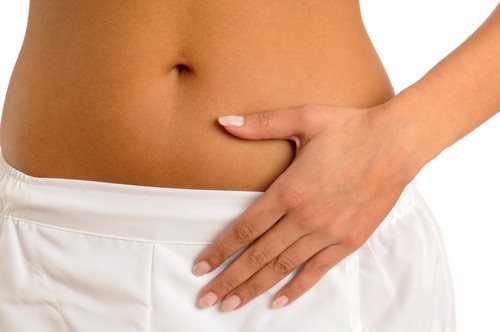
A characteristic sign of an exacerbation of an ulcer is the cessation of pain after vomiting, since the removal of food from the stomach reduces acidity and temporarily relieves discomfort by cleansing the mucous membranes.
Pain in the upper part of the stomach
Discomfort has a pronounced frequency after eating and is marked by the appearance of a burning sensation with a feeling of heaviness in the stomach. In this case, similar symptoms develop with angina pectoris. A distinctive feature is the increase in unpleasant symptoms during physical activity.
Pain in the middle part of the stomach
Unpleasant sensations are recorded in the epigastric region on the left side of the abdomen in the middle. Moreover, they have a pronounced periodicity and occur after eating.
The nature of pain in pyloric ulcers and duodenum
Pain during exacerbation of the disease can have the following intensity:
- periodic with attacks occurring several times a day;
- longer lasting pain of gradual increase;
- the occurrence of pain in the right hypochondrium due to the development of spasm in the sphincter due to inflammation of the duodenum.
Discomfort when an ulcer worsens can also develop in other parts of the body. The types of pain are discussed in more detail below.
Headache
The development of migraine with an ulcer can be caused by side effects of medications or by constant debilitating vomiting, which causes tension in the head muscles.
With constant headaches and exacerbation of the ulcer, bleeding can be suspected, since blood loss contributes to a significant deterioration of the condition. This condition is extremely dangerous for a sick patient and requires immediate hospitalization.
Back pain
Unpleasant sensations in the back often occur due to disruption of the digestion process in the stomach. Symptoms develop faster than the disease, so the diagnosis is not always correct.
With further progression of the disease, the appearance of other characteristic symptoms (nausea, vomiting, bitterness in the mouth) and the identification of the true cause of back pain are noted.
Stomach ache
Determining the cause of abdominal pain depends on the location of the pathology and is determined by palpation during an examination by a doctor and further conducting the necessary research.
How and where does pain occur?
Patients turn to the doctor complaining of pain in the epigastric part of the abdomen, that is, from above. By palpation, the doctor determines what exactly causes the pain.
Important! Abdominal pain is the most common complaint of patients when visiting a doctor. However, this type of pain can indicate not only gastrointestinal diseases, but also the presence of other serious diseases. Therefore, you should not diagnose yourself.
Depending on what pain the patient experiences with a stomach ulcer, the doctor determines which part of the stomach is affected by the disease.
- If the pain is localized high enough, radiates to the heart and is not intense, then the subcardinal and cardinal sections of the stomach are affected. Accompanied by belching, vomiting, heartburn.
- If it hurts in the epigastric region, that is, on the left and the nature of the pain is aching, it means that the lesser curvature of the stomach is affected.
- If the epigastric region hurts and the pain is accompanied by sour belching and heartburn, it means that the arterial section is affected.
- If the pain is intense, paroxysmal and lasts more than 40 minutes, and prolonged heartburn occurs, it means that the pyloric canal is affected.
Is it possible that there is no pain with an ulcer?
An ulcer in a chronic form can proceed quietly without the manifestation of acute symptoms and be diagnosed only when there is bleeding or another complication. The absence of pain is possible for the following reasons:
- high threshold of pain sensitivity;
- slight damage to the gastric mucosa;
- the process of rapid regeneration of damaged tissue.
In most cases, the ulcer still has clear, pronounced signs that are difficult to miss. If suspicious symptoms appear, a consultation with a qualified gastroenterologist is required.
How to quickly relieve pain
Elimination of pain in acute ulcers is possible only with prior consultation with the attending physician, who will prescribe safe and effective remedies. It is also necessary to follow a diet with a properly selected diet.
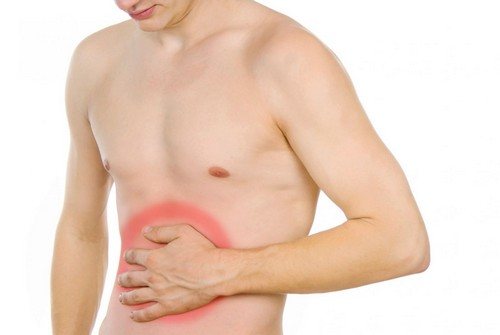
Medications
To eliminate all negative symptoms, drugs of the following category are effective:
- anticholinergic drugs (Gastroceptin, Platyfillin);
- antispasmodic tablets (Metacin, Nosh-pa, Spazmolgon);
- gaglioblockers (Dikalin, Kvateron);
- preparations containing bismuth (Bismol, Ventrisol, De-nol, Tribimol);
- antacid medications (Maalox, Vikalin, Phosphalugol).
Before the onset of severe pain, you can drink alkaline water in advance to obtain an analgesic effect. Milk is a natural antacid, so doctors recommend consuming the product before bed.
Elimination of unpleasant sensations is possible by using physiotherapeutic procedures (magnetic therapy, modulated currents), which promote rapid healing and scarring of tissue.
Folk remedies
Folk remedies for ulcer pain help eliminate all unpleasant sensations. The advantage of this technique is the naturalness of the ingredients used and relative safety compared to drugs of chemical origin.
The most effective traditional medicine recipes are discussed in the list below:
- propolis tincture, diluted in water in a ratio of 1 tbsp. spoon per glass of water. The resulting remedy is drunk in the evening for 20 days;
- sea buckthorn oil in the amount of 1 tbsp. spoon 30 minutes before meals, as the product envelops incoming food and does not cause unnecessary irritation on the walls of the stomach;
- decoction of herbs (chamomile, calendula, horsetail, rose, dried grass, wormwood, burdock, dill seeds, rose hips, St. John's wort, yarrow, plantain). The finished product is taken 20 minutes before meals in an amount of 20 ml;
- An infusion of dried or fresh blueberries is taken 4 times a day throughout the course of treatment.
One of the effective methods of eliminating pain from ulcers is following a diet with the consumption of certain foods that are prepared using safe methods.
Prevention
Prevention of ulcer pain depends on following the recommendations below:
- timely treatment of gastrointestinal diseases (gastritis, duodenitis). These pathologies, which develop into a chronic form, significantly increase the risk of developing an ulcer with the appearance of an aggravated syndrome. For control, a test for Helicobacter pylori is required;
- proper nutrition in the presence of a stomach ulcer (exclusion of sour, salty, spicy, smoked foods, alcohol, cigarettes, sour fruits, products containing artificial substitutes);
- adherence to a regimen of fractional meals up to 7 times a day every 2–3 hours;
- prohibition of taking medications that may adversely affect the functioning of the digestive system (aspirin, corticosteroids, non-steroidal analgesics). All medications must be prescribed by qualified specialists if there are clear indications for use;
- undergoing preventive treatment in special sanatorium resorts. These institutions have a course of unique procedures that are aimed at quickly restoring the body and maintaining health;
- eliminating the constant occurrence of stressful situations and nervous disorders with a predisposition to ulcers and the presence of other gastrointestinal diseases.
